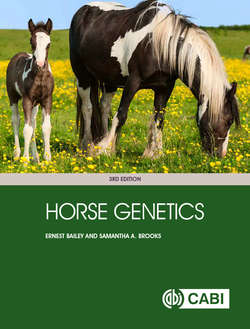Читать книгу Horse Genetics - Ernest Bailey - Страница 6
На сайте Литреса книга снята с продажи.
ОглавлениеPreface to the First Edition
Basic genetics textbooks seldom mention horses. Horse breeders tell me that they cannot relate fruit flies, corn, and mice to practical horse breeding. This book aims to provide a good overview of genetic principles using horses as the primary examples. I have sifted and distilled facts and ideas to provide horse breeders with relevant illustrations. While providing a basic primer, I will not oversimplify to the point of inaccuracy. Students and science professionals can confidently use this handbook as a resource.
Do not expect to read this book from cover to cover! In my years of teaching, I have found that genetics is a subject that can only be taken in small doses. When you reach your saturation point, stop for the moment to return at another time.
Browse the contents, the pictures and tables to become familiar with the material present. You may want to read only selected chapters or sections. The index may point you to several sections discussing a subject of particular interest. If you wish to read the original research papers, the reference section provides the citations to find them in a university library. You will probably want to have a general genetics textbook at hand to refresh your memory or to provide alternative and more detailed examples of basic principles.
Knowledge about horse genes lags well behind that for human or mouse, or even for genes of other domestic animals such as cow, pig, sheep, and chicken. Since the horse provides only a very limited set of examples, readers keen to know more about genetics are encouraged to consult current texts in general genetics. I especially recommend the veterinary genetics textbook by Nicholas (1987) [current edition
Nicholas, F.W. (2010) Introduction to Veterinary Genetics. Wiley-Blackwell, Ames, Iowa] for its wealth of animal examples.
You may find the contents overwhelmingly detailed about Paint horse pattern genes. The emphasis is a reflection of the many inquiries I receive from Paint breeders. Even if white spotting genes don’t pertain to your breeding program, they provide examples to help you practice thinking about horse genetics. You may be disappointed that no discussion is provided on a particular subject important to your breeding program. Information specific to horse genetics comes at a price. Government-funded agriculture programs support research on food and fiber animals, not companion animals. Knowledge about horse genetics will be forthcoming in direct proportion to how much money is invested. Without money being committed to horse research by horse breeders, our understanding about genetics of humans, mice, and cattle will continue to advance rapidly, but knowledge about horse genetics will only unfold slowly.
Readers of this book will find answers to many of their questions about the genetics of horses, but I hope that other questions will replace them. Learning is a continuous process that does not end with finding answers. The path of knowledge is learning to ask questions and to build new questions from the answers.
Ann T. Bowling
1996
